Learn everything you need to know about Gen AI and get tips on using it in everyday life

What is Generative AI?
Gen AI or generative AI, as the name suggests, is a technology that generates a variety of media based on inputs from the end user.
Simply put, you can use generative AI to create videos, soundtracks, and images depending on what kind of media you want. And if you are looking for text-based outputs, gen AI can create stories, and write songs, and poems. Or, if you own a business, you can use it to generate human-like responses in a chatbot application to troubleshoot a customer’s problems.
And that’s not all. Software developers can use generative AI tools to write complex and lengthy source code in a jiffy, thereby maximizing their efficiency and reducing development costs.
Yes! Generative AI is that good. But more than that it is also incredibly easy to use and its applications are only limited by the user’s imagination.
Later in the article, I’ll show you how I use gen AI to plan everything from movie night to a vacation, allowing me to focus on enjoyable tasks and minimize time spent on the boring stuff.
Can anyone use generative AI?
Well! The answer is not as simple as a yes or no.
On the one hand, Yes! Anyone can use generative AI. Most gen AI tools are easy to use and won’t cost you a penny to experience.
However, the real question pertains more as to what to use gen AI for. This is where I would suggest you be a discerning.
Why? You may ask!
Gen AI is great for things like writing a song or advising you on which movies to watch.
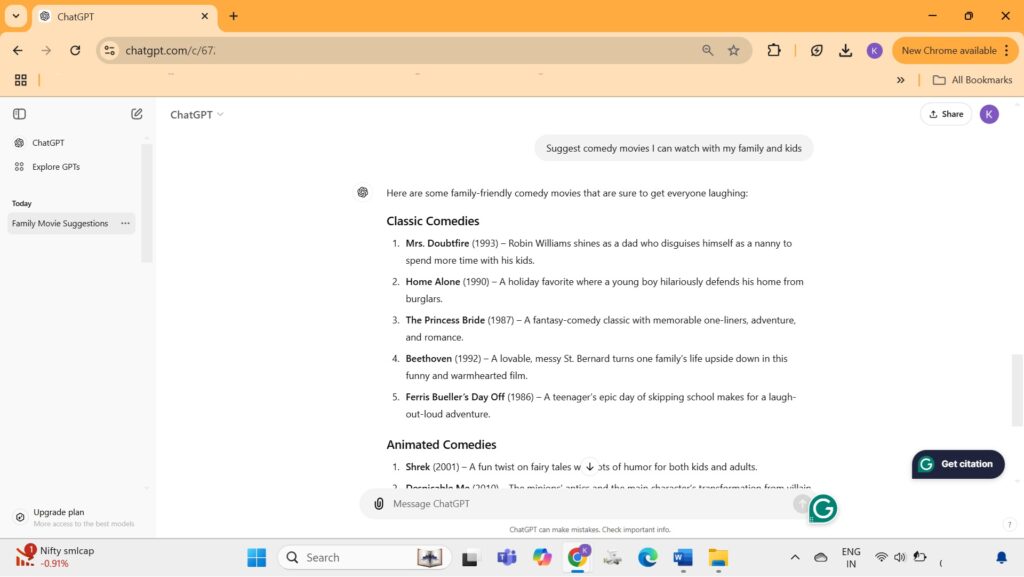
But it has limitations.
For instance, seeking medical advice using a gen AI tool like ChatGPT is perilous.
Sure, you can use ChatGPT to summarise possible lines of treatments, but it’s not a replacement for a clinic visit where the doctor considers all your parameters to recommend a cure.
In this use case, gen AI is a great tool for your research, allowing you to consult your doctor in a more informed and educated manner. However, treating yourself without professional medical supervision is risky and you should avoid making that mistake at any cost.
The Gen AI model: How Gen AI works?
Gen AI works a lot like humans do when we write an essay (or give a presentation) on a subject.
If you think about it, we begin by referring to books, while our mind focuses on understanding what we read. We make notes on key concepts and use these notes to write our essay (or make our presentation).
At the heart of it all, gen AI does the same. It uses the same model.
The dataset acts as books that are vast repositories of data that contain comprehensive information.
Machine learning algorithms act as the mind, that makes sense of this information by studying and identifying various patterns in the data.
Gen AI then trains its Neural Network which acts as it notes that it will use for generating responses.
The response (the essay, presentation, or answers) is the generated output that the model produces by using the neural network (or notes).
Generative AI uses this model to generate the next word, musical note, video frame, or image pixel depending on the media you use gen AI for.
Are all generative AI alike? And, what are the different types of gen AI?
Generative AI models come in various forms. Expectedly, each gen AI type is suitable for handling a specific media type and ensures you get optimized AI-generated content that caters to your needs.
Below are some commonly used gen AI models.
Generative Adversarial Networks (GAN)
GAN models pit two opposing neural networks to create AI content. The Generator and the Discriminator (the two neural networks) mimic two colleagues where the Generator is responsible for creating the content and the Discriminator verifies whether the content is real or generated.
In a way, the two neural networks are pitted against one another to ensure that the generated content is complete and accurate.
Variation Autoencoders (VAE)
Like GAN models the VAE model also uses two neural networks, but differ in how they work.
Instead of a generator and a discriminator, the VAE uses Encoders and Decoders.
When the encoder receives input data it analyses it and condenses the data into an information-dense form so that the decoder can use this condensed data to re-create appropriate responses.
So unlike GAN models, where two neural networks are pitted against each other, VAE’s neural networks collaborate to present new data samples derived from the learned dataset.
Transformers
This gen AI model begins deconstructing an input by assigning weightage to key portions of the input. By doing this it interprets the context of the query viz-a-viz the dataset and predicts suitable responses.
The most noticeable application of this is when Gmail suggests quick responses to your emails or when you are typing a sentence and Gmail suggests the next few words.
Recurrent Neural Network (RNN)
RNNs analyze the training dataset and identify and learn newer sequential data derived from similar instances in the dataset. In many ways, it’s the AI equivalent of practice makes perfect.
Internet search engines make for an excellent use case for RNN models. Say you look up the cast of the movie Apollo 13 by typing in “Apollo 13 cast” and start reading about Tom Hanks. Even before you begin the next search, the search engine suggests other cast members like Bill Paxton, Kevin Bacon, Ed Harris, and others.
Pros and Cons of Gen AI
While Gen AI tools promise to revolutionize the way we create content, they have several limitations that pose unique challenges for its wide-scale acceptance in the creation of certain media types.
Media like music and videos are often considered works of art. Undoubtedly, you can use gen AI to create trending music. But in my opinion, the day that AI-generated music will be considered a work of art is still to come.
Pros of Gen AI
Automation
Man invented machines to ease their workload and standardize the output, gen AI is no different. Gen AI tools can automate anything from content creation to providing diverse insights for a given dataset.
For instance, gen AI tools like ChatGPT, Perplexity.ai, Microsoft Copilot, and similar products are great for automating customer support roles in your business.
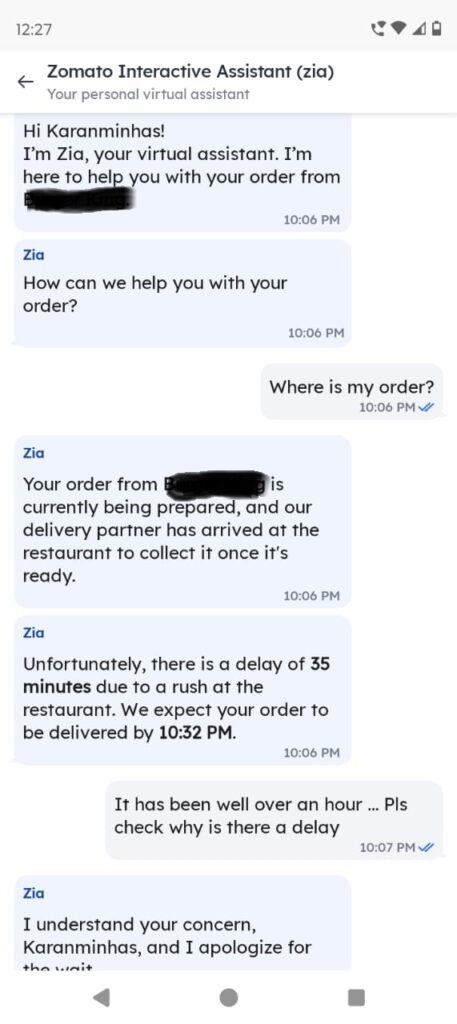
What’s more? Several writers, content creators, small businesses, and large enterprises have been using gen AI tools for everything from research to automation of complex workflows like handling logistics and ERP.
Cost Effective
Gen AI tools are cost-effective. While this might mean little in the context of a writer wanting to research a subject, but large enterprises can enhance productivity with better management of their resources.

Automating repetitive tasks using AI-based applications allows enterprises to redeploy their human resources more efficiently. Gen AI mimics human intelligence, and responses (in some cases), well enough to warrant large companies to bear the initial setup cost with the larger aim of enhancing productivity.
Spotting Trends
AI tools are excellent at data analysis and trend spotting, making them viable for roles that involve analyzing voluminous data tasks like policymaking, decision-making, or predicting trends.

Procurement and sales management roles are ideal for AI-based tools because both these roles generate vast quantities of data and play a key role in the success or failure of a business.
Gen AI Limitations
Training Data
Despite its many benefits, gen AI’s biggest limitation is sourcing relevant data that you can use to train the neural network.
An AI-based application’s effectiveness is only as good as its training dataset. While enterprise-level applications will have plentiful and diverse data to train an AI model, getting relevant data for innovative applications is challenging. Such apps rely on synthetic data which can prove to be unreliable due to it being selective and deficient.
For instance, AI models that forecast sales will be successful considering it has years and years of historical data to go by. On the other hand, developing an AI-based app that helps doctors diagnose a skin disease by simply taking a picture would require documented images of various skin infections.
Other possible considerations would be stages (of the disease), skin types, areas of infection, or even the patient’s race. An AI-based app would require hundreds (if not more) of images to train its neural network to arrive at an accurate diagnosis.
Data Bias and Quality Control
Gen AI models need to have reliable and accurate data. Without relevant data, AI models will have biases that compromise the output quality.
For example, to test the veracity of a popular GPT model, I presented it with a trick question seeking the personal score of a cricketer in a match that I knew he wasn’t playing. Shockingly, the model fell for the trick and generated a completely bogus response.
To be fair, this was in the early days of the release of the model (read it was in beta testing). And recently when I tried the same trick, the model gave me an accurate answer.
Nevertheless, the key takeaway is that when an AI model lacks relevant data, it is known to manufacture its own, or as some people call it, hallucinations.
Uninspired Output
Gen AI outputs are uninspired and synthetic compared to human-generated outputs.
Take the case of art. Paintings like Starry Night by Vincent van Gogh, or The Night Watch by Rembrandt are, and have, inspired works of art.
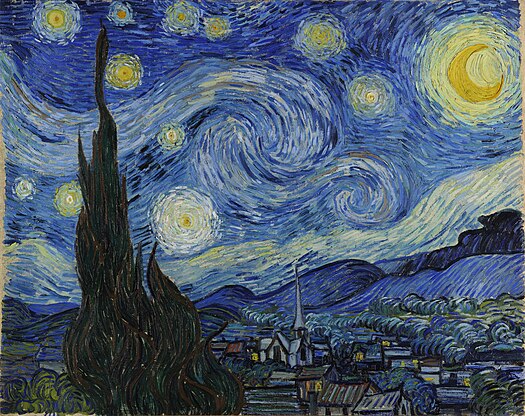
Believed to have been created in 1889 over a weekend in June when Vincent van Gough was in an asylum recovering from a breakdown, the Starry Night is the product of Van Gogh’s conflicted emotions and the inspiration he drew from what he saw outside his window, which is mixed with his creative vision.
While Vincent van Gogh painted Starry Night over a weekend, Rembrandt took three years to complete his masterpiece. His creative use of light and shadows was unique and awe-inspiring.
Gen AI outputs are synthetic, in that they are “machine-made.” It is based on a limited data set and set of rules with very little understanding of emotion, creativity, and sensibilities. So while gen AI is capable of creative visualization (at best), don’t expect an inspired masterpiece.
How Can I Use Gen AI?
Despite several limitations of gen AI, gen AI tools are a quick and convenient means of accomplishing several tedious and repetitive tasks. Such tools are versatile and finding a use case is limited to one’s understanding (and imagination) of how best to use them.
There are several gen AI tools in the market and the best way to choose which one suits your needs is to determine whether you want to use it for personal or professional use.
ChatGPT
For instance, you can use ChatGPT by logging onto the OpenAI website and using the interface to fire questions at the AI model and receive responses as if chatting with a real person.
It has a free and a paid version (ChatGPT Plus). While the free version is great for several beginner-level and personal tasks, ChatGPT Plus is better suited for professionals needing enterprise-level responses.
Being a text-based interface, you can use ChatGPT to generate code in almost any programming language. Simply type in, “Write a program in C++ that takes two integer inputs from a user and displays its sum.” and presto! ChatGPT swings into action and generates the code within seconds.
But most people don’t have any use for coding in everyday life. So, what else can ChatGPT do that you can use daily?
How Can I Use ChatGPT At Home?
A real-world usage of ChatGPT is to ask it to “Create a five-day itinerary for a visit to London and include restaurant recommendations and tourist sites to visit.”
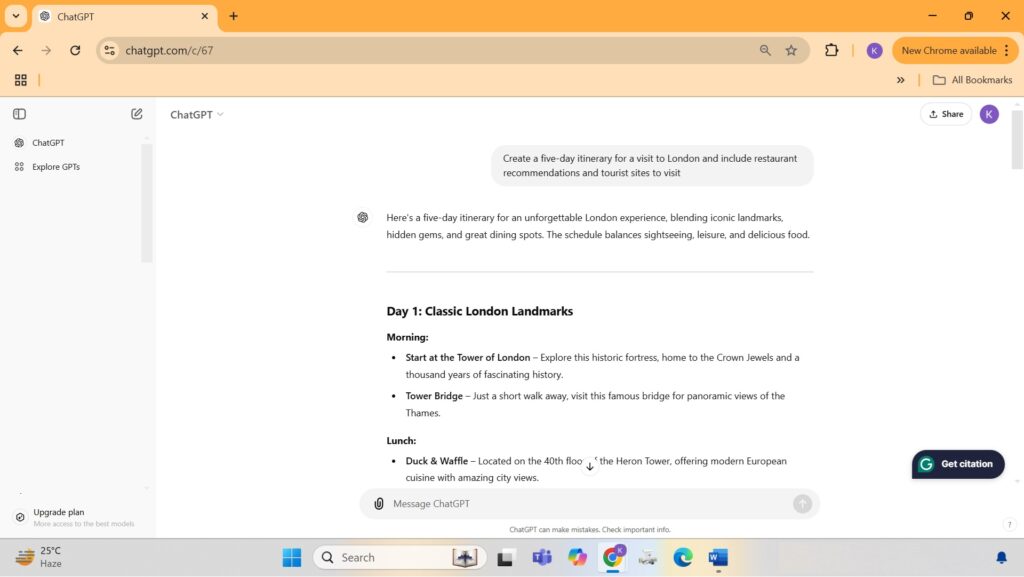
ChatGPT is also an excellent research tool. It can sift through vast amounts of data and present discrete information that may take considerable time to discover. But one needs to be discerning about the results and I make it a point to double-check the veracity of information I am unfamiliar with.
Bloggers are using it to write informative (and viral) content. Once you get the hang of it, you can use gen AI tools to write buying guides and use these articles to setup an affiliate marketing business.
Besides ChatGPT Plus, OpenAI also offers an API that allows you to harness the power of ChatGPT and integrate it into your business. Whether it’s an application, website, or a service that you offer, you can integrate ChatGPT into a wide range of applications.
Dall-E
Like ChatGPT, DALL-E is also owned by OpenAI. It’s a handy tool for graphics designers who can use DALL-E to create images using verbal descriptions.
The interface works much like the ChatGPT interface, allowing you to provide text input, but instead of generating a text-based result, it generates an image that the user describes.
It minimizes the workload of a graphic designer. By creating basic images it enables the designer to focus on editing, a far more tedious task. DALL-E is an excellent visualization tool with diverse applications ranging from creative design to developing visual cues for business presentations.
For everyday scenarios, you can use DALL-E to create professional-looking invites, party banners, or even greeting cards for loved ones.
Mini Max and Video-based Gen AI
Mini Max is a gen AI video creation tool. You can use it by writing a description of the video you have in mind, and the AI engine will swing into action and create the video in minutes.
However, the cooler function is that instead of letting the AI engine decide the aesthetics of the video, Mini Max allows you to use an image as the starting point (or the first frame of the video). From there, you can use descriptive text to generate the video, adding elements that you want in the final cut.
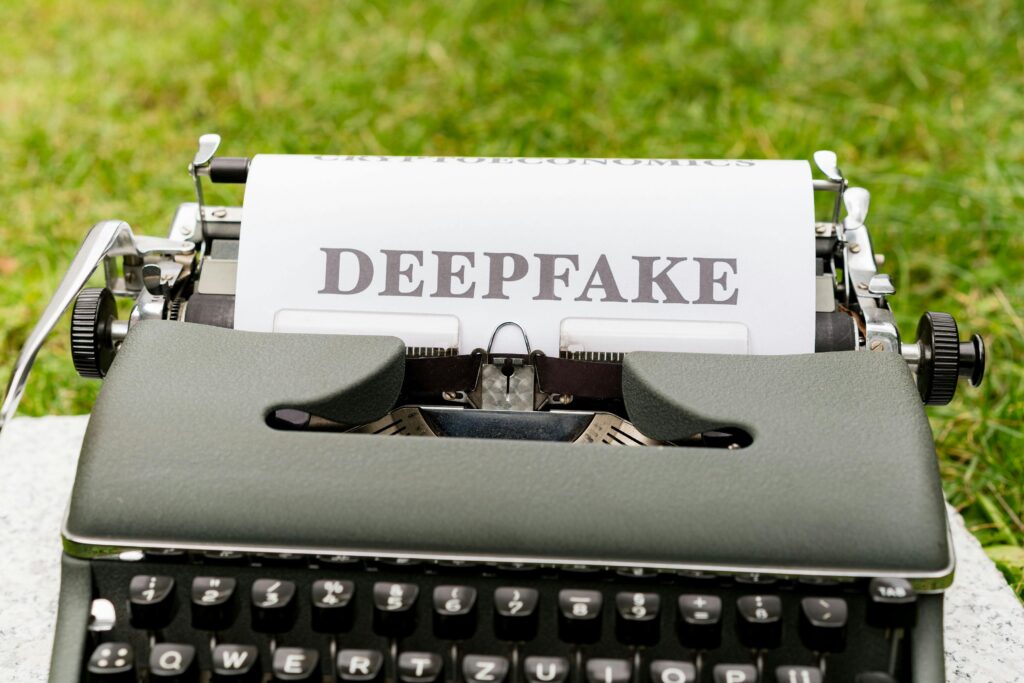
Interestingly, there are several advanced video generator models that you can use to create things like marketing and advertising collateral. They allow you to modify stock video or audio streams, using the images of known personalities. Although labeled “Deepfakes”, you can use these collaterals for commercial purposes if you take the necessary permissions from all concerned parties.
Will Gen AI Take Away Jobs?
There is no doubt that gen AI is here to stay and the discussion around AI replacing us (read our jobs) is causing anxiety for many. But whether it will replace you will depend on the nature of your work and whether you upskill.
The advent of new technologies always brings plenty of opportunities to learn and upskill. Conventional wisdom has always taught us to move with the times, and the mainstream acceptance of gen AI is no different.
Sure, you can use the gen AI tool for writing everything from fictional stories to complex code in any programming language of choice, but these works won’t be possible without prompts. And this is where one needs to know how to use gen AI tools.
So, while it will not replace most work profiles, the work profile itself will certainly change.
Many companies have adopted gen AI chatbots for troubleshooting customer complaints but continue to have backup agents to handle customer queries for instance where the problem becomes too complex for the chatbot to solve.
Unfortunately, that is only a half-truth, these chatbots can handle the bulk of the queries allowing most companies to (if not just consider) downsize their customer support.
On the other hand, such companies also require AI-savvy engineers, thus presenting an opportunity for a completely new work profile. Deployment of AI-based applications requires a special training and skill set, hence warranting more jobs.